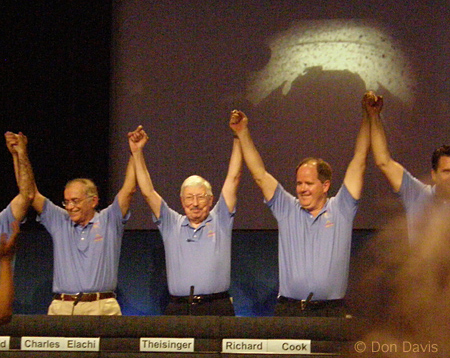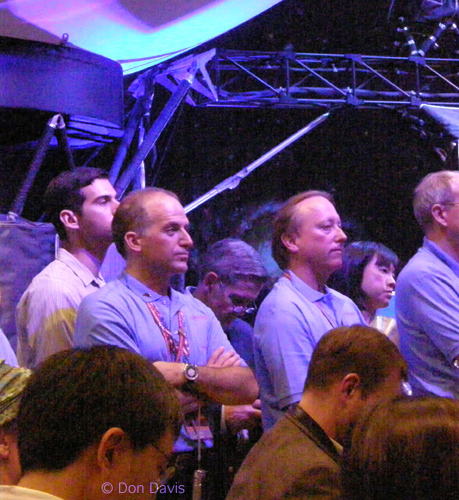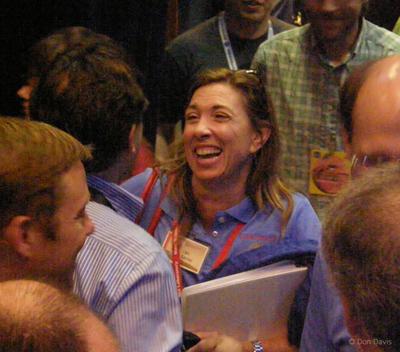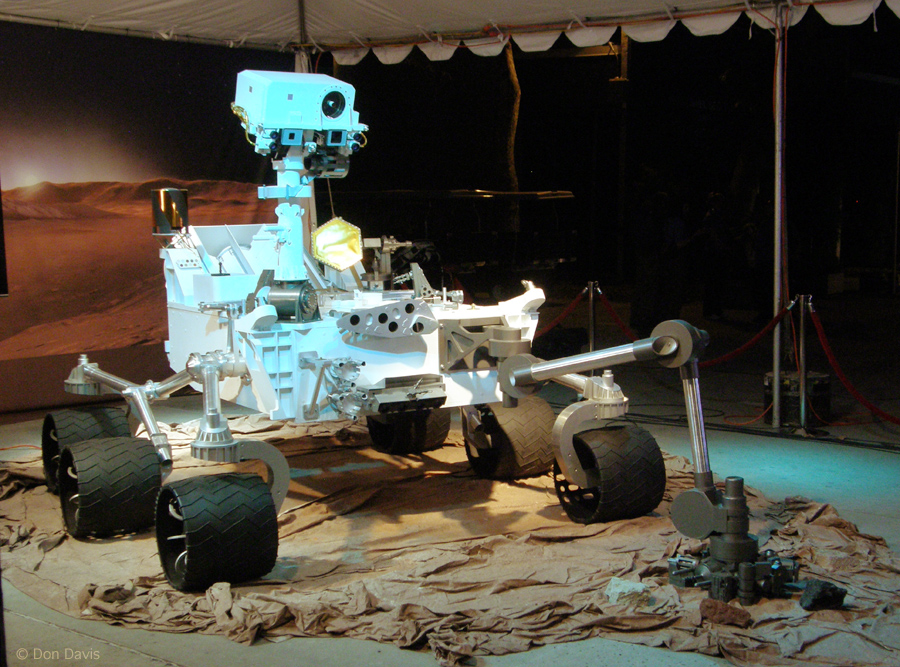 The
first image from the rover was a tiny thumbnail from the rear
HAZCAM left side. Looking from close to the surface, it showed
at first little more than a bright sky with a late afternoon Sun
over a fisheye lens curved dark horizon, but it was our first
glimpse of this new place. The clear dome protecting the camera
was spattered with dust clods, proving the wisdom of their presence.
The
first image from the rover was a tiny thumbnail from the rear
HAZCAM left side. Looking from close to the surface, it showed
at first little more than a bright sky with a late afternoon Sun
over a fisheye lens curved dark horizon, but it was our first
glimpse of this new place. The clear dome protecting the camera
was spattered with dust clods, proving the wisdom of their presence.

(above) The first glimpse of the Surface from a wide angle
camera near the ground looking toward the Sun. The dark area in
the sky at the middle of the horizon is a dark dust cloud kicked
up by the 'Sky Crane' as it crashed in the distance. The cameras
were protected by a clear dome which shows clumps of dust clinging
to it in both hazcams pointed in that direction. The simultaneous
exposures of both cameras allowed them to be superimposed so the
dust clumps tend to 'cancel themselves out', emphasizing the real
detail including the dust cloud in the distance.
A page dedicated to Gale crater and some of the initial images
from the Curiosity Rover is here.
(right) Peter Theisinger, MSL Project Manager, below the first
image returned by the Curiosity Rover. Theisinger was later named
by Time Magazine as one of the 100 most influential people in
the world for his role in the success of the landing.

Next we saw the rover's long shadow thrown
toward the horizon, with a mountain dimly shown above a dark done
outlined horizon. Moments of handshaking, hugs and triumphant
conversation across the auditorium were overseen by joined upheld
hands on the stage.

There were instances of celebration breaking
out among the speakers as others arrived, and at one point many
of the blue shirted controllers came in and mixed with the media.
It was joyous chaos more than once. There was a tendency for the
photographers to mob the stage, causing exasperated cries of 'Down
In Front' from the camera operators toward the rear.

(above right) I wanted to make sure an image or two existed
of me there, thanks to helpful folks nearby it happened. It was
as glorious a nght as JPL had ever seen since the 1976 Viking
1 landing, which was my first time in that auditorium. Unlike
those early days, I was the only space artist in that room, although
others were elsewhere at the lab through their own twists of destiny.

Whimsical rituals were in evidence, one before
landing involved sharing peanuts from a mission labeled jar. This
was started after the first successful Ranger Moon probe after
a string of failures was broken and it became known one of the
controllers was eating peanuts. A jar of red marbles representing
days to landing were finally transferred from one jar to another
that day. Mars candy bars were also widely distributed. I saw
people I knew, shared impressions of the night, of relief and
enthusiasm for what was to come.
The celebrations and congratulations reberverated among those
gathered there for hours. Various dignitaries from NASA Headquarters
made the rounds, including a pleased looking Lori Garver (right)
After a last look at the Rover model in the courtyard with the
waning gibbous Moon high in the sky, around 1:30 AM I decided
to start the nearly two hour drive home. Along the way I listened
to news reports about the event I had just been to. Once more
I managed to be at the most important place in the world on that
day. Jupiter has risen in the East, looming bright and steady
as I drove the quiet freeways. After the Palm Springs turnoff,
the darker stretch before town revealed along the desert horizon
Venus rising, bright and yellow at first. The end of this long
and eventful day came for me at dawn.

(below) in the video of the NASA TV coverage I can be seen
taking photos in all directons compiling panoramas like this.

Above) a crop of my 'celebration pan'.
(below) The entire pan, reduced.

Just before leaving, I obtained this photo of the true size
replica of the Curiosity Rover, now safely on Mars.
 The
first image from the rover was a tiny thumbnail from the rear
HAZCAM left side. Looking from close to the surface, it showed
at first little more than a bright sky with a late afternoon Sun
over a fisheye lens curved dark horizon, but it was our first
glimpse of this new place. The clear dome protecting the camera
was spattered with dust clods, proving the wisdom of their presence.
The
first image from the rover was a tiny thumbnail from the rear
HAZCAM left side. Looking from close to the surface, it showed
at first little more than a bright sky with a late afternoon Sun
over a fisheye lens curved dark horizon, but it was our first
glimpse of this new place. The clear dome protecting the camera
was spattered with dust clods, proving the wisdom of their presence.


